
Beatrice Von Rague Schleyer and Mïï Gunn
October 16, 2023
In the Spring of 2019 Ï was overcome with the opportunity to curate a series of impossibly charming and imaginative art-interventions with the enigmatic Beatrice Von Rague Schleyer (aka Juju Mechanics) in a massive E Side warehouse space (aka Arnold’s). It started the way that any Detroit-version of symbiosis might—out of desperation—and it closed like the boss funeral we all deserve: to the throwback sounds of Newcleus, a low rider parade, and Yangnyeom Galbi for days.
In Beatrice’s time stewarding Arnold’s, the city of Detroit was re-narrativized at least 10 times, from all sides. It was a wild time to be alive in the world, and a wild world to be trying to make sense within, especially as a young artist— reaching for a concept of home. Arnold’s, in the grace of Bea’s Juju Mechanics (in my opinion) embodies that time and that reach—the art of generously risking possibility.
-Mïï
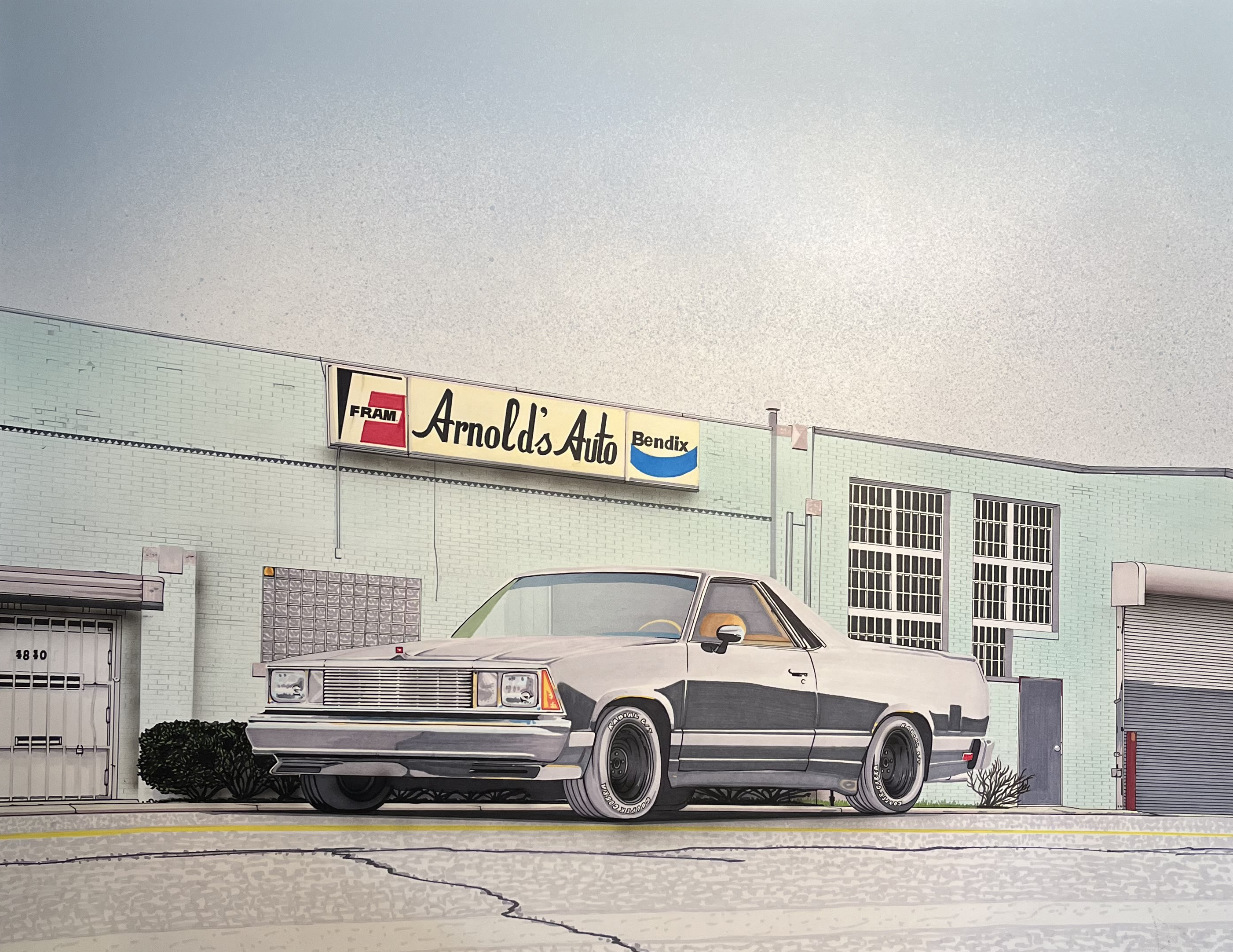
Mïï: Peace, Bea. Can you give a brief origin story of what brought you to Detroit?
BVS: In the Spring of 2016, I loaded up the bed of my El Camino and headed to Detroit, leaving my childhood home behind forever. After my father’s death in 2010, I moved back to the house, fixed it up and sold it. I had been visiting Detroit since 2013, and felt it calling to me. My part of the proceeds from the sale seemed like they would go a lot further there than in New York. My career as a performance artist didn’t seem like it was going to provide much stability for the future- I had already burned through a lot of my dad’s life insurance money trying to cultivate it - so I figured moving to Detroit, investing in a warehouse and learning a trade might give me a greater sense of agency and security as I headed into my 30’s.
I managed to catch a case on one of my early visits to the city, having participated in an improvised midnight shooting gallery in the same neighborhood I would eventually call home. I met with a realtor to look at properties when I visited for court dates, but it wasn’t until I officially relocated that I started hearing about Arnold’s from friends- like so many of the best things I’ve encountered in Detroit it didn’t reveal itself til I had some skin in the game.
Mïï: Shortly after this you moved into Arnold’s – a massive former automotive shop by the Packard Plant– in 2016. What was the space before you purchased it, and what did it feel like when you got there?
BVS: I didn’t know much about commercial realty and had no idea what I was getting myself into when I put everything I had into buying this 15,000 square foot building. The full name of the business was Arnold’s Auto Electric Sales. They specialized in fixing starters and alternators. It had been left as if everyone running the business had disappeared in the night. Cigarette butts still in ashtrays improvised from rotor hubs, actual ashtrays full of car keys with no corresponding cars. The only car on the premises was a bombed out 90’s Ford Taurus on blocks at the back of the garage, which later would be used in several projects in the space. I cleared out the offices, reception and customer waiting areas to make my living quarters, and turned the employee bathroom into a shower room with a bathtub.
Mïï: Not just any bathtub though. You built out the bougiest bathroom ï had ever seen. Japanese soaking tub, heated floor, intricately soldered copper pipes for the fixtures. Ï would joke that the freshest bathroom in Detroit was in the least likely place, but in many ways your early time with the space became an unlikely microcosm for understanding the city.
How did the city welcome you once you were settling into Arnold’s?
BVS: The first winter there was rough, punctuated by a New Year’s Eve party I hosted where a man walked across my family’s dining room table and a friend shot his AK-47 into the pavement at midnight.
Mïï: This feels reminiscent of the shooting range you caught the case with, and your (and some of my) early experiences in Detroit. Would you say that this was somehow signifying a shift in a naïve or destructive relationship with the city? & What did that NYE bring up about what the future may hold?
BVS: My future mentor, the sculptor and metal fabricator Eric Froh, attended that party. We had met but weren’t working together yet. He was a bit shocked by the gold lamé brocade suit I was wearing and by the decadence of the tub room. That exchange telegraphed the way our relationship would eventually evolve when he got to know me better as an artist/entity beyond my role as his shop dog. I started my apprenticeship with him in March of 2017.
I understand the tradition of shooting guns at midnight on NYE to be some kind of “show of force”, and have less conflicted feelings about it than the improvised shooting range. There are other folks in the neighborhood who observe the tradition of the NYE volley at midnight, but after getting to know the neighborhood I realized that during the range excursion we were shooting guns in an area that despite feeling industrial and being next to the Packard Plant is quite residential. Hearing random gunfire is much more unnerving than when it’s expected during the holiday, and I’ve come to be aware of that transgression and the misapprehension of where I was.
Mïï: A naïve and destructive relationship with the city in a period of great transformation and great potential, Ï should say. For me, it felt infinitely spaced in a way that now is hard to not read a “blankness” narrative into. But also, from an extremely narrow view, it was beautiful to be able to see so much vastness in a place. Ï can’t at this point condone what was done with that idea in those early days, but ï can say that having somewhere feel like life really could be what you make of it, however brief and contorted, was an incredible gift to believe in as a young artist. The possibility for that to become a generative energy was strong.
BVS: I deeply agree with that sentiment. Arnold’s was the filament of my relationship with the city, and I was slowly learning what possibilities the space could open. I was renting space to friends, including Joe from Detroit Grease who was one of the people that led me to the building. Joe married his lovely wife Sarah Grace that spring, and we held the after party in the garage.
Mïï: That was my first memory of an event at Arnold’s. It was low maintenance but gloriously aesthetic. There were lights on the chain hoist and the El Camino overflowed with tropical foliage. Our wacky friend Dmagz interpreted the wedding attire: “come stunting or in costume” to mean: “come dressed like a vending machine”. At the afterparty, something got set off and Rocky attacked— and the chips went flying. It was such a salty jubilance.
BVS: The snack mandala was an epic moment, but a pain in the ass to clean up. Later that year Rocky got into a terrible car crash on her way out of town so we held a benefit to help cover some of the medical expenses. As part of the event I did one of my all time favorite performances. I used the Taurus as a stage. I started inside the car, worked my way to the roof, and then grabbed the hoist hanging from the XY crane and swung off, briefly suspended with a clip lamp as a microphone lip synching to Frank Sinatra’s That’s Life.
Mïï: Ï remember. There were blacklights and paint everywhere. We all looked like we had been in a glowstick massacre. How was this related to the work you were doing before in NY? And what influence did being at Arnold’s have on your work?
BVS: In New York I was dancing with a Butoh company called the Vangeline Theater. The pieces we did at that time were quite formal, and by contrast my solo performances were much more chaotic and sexual. In Detroit the way I addressed my femininity changed; I became less interested in a transgressive display of sexuality and focused more on the intersection of my technical life and AFAB body. I debuted a piece based on the execution of Joan of Arc at an exhibition called The No Show where I dance with a chain hoist, pulling myself into the air and then bringing myself back down. Tools like the chain fall were becoming familiar friends in my work as a metal fabricator.
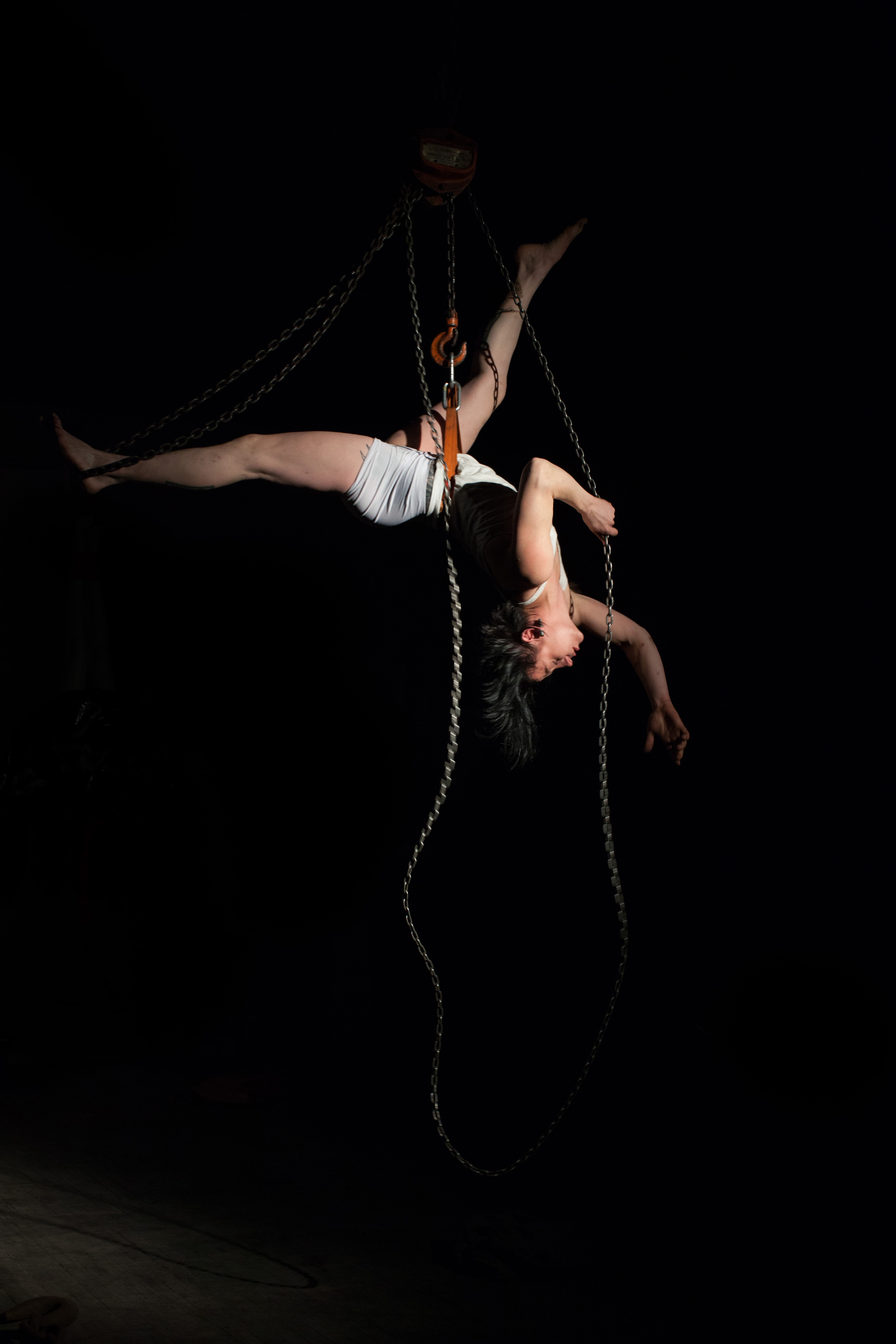
Meanwhile I had been working on footage for interference//, an on-going collaboration with my oldest friend, multimedia artist Sky Goodman. I create source footage and dance bathed in its projection while Sky uses analog feedback and other tools to glitch the video feed live. Originally the footage had always been filmed on a black background, but having Arnold’s opened new possibilities. One of my first sculptural furniture projects was a throne- I welded a geometric base of nested steel rectangles to support an auto seat. I made a headpiece from parts I had found around the shop, and used these objects in vignettes filmed around the building. It had the feel of a run-down post apocalyptic space station. In the footage I danced with cars and motorcycles, my welding table, rolling partitions I was building for Matthew Angelo Harrison’s studio.
The first serious performance event I held at Arnold’s was the debut of this work in the winter of January 2019. I painted one of the walls in the garage white to provide a backdrop for the projection. Onyx Ashanti and my dear friend Margherita Tisato joined the bill, book ends of the human - technological themes of interference//.
In the summer of 2019 we did our first collaborative group exhibition. Can you talk about how that came to pass?
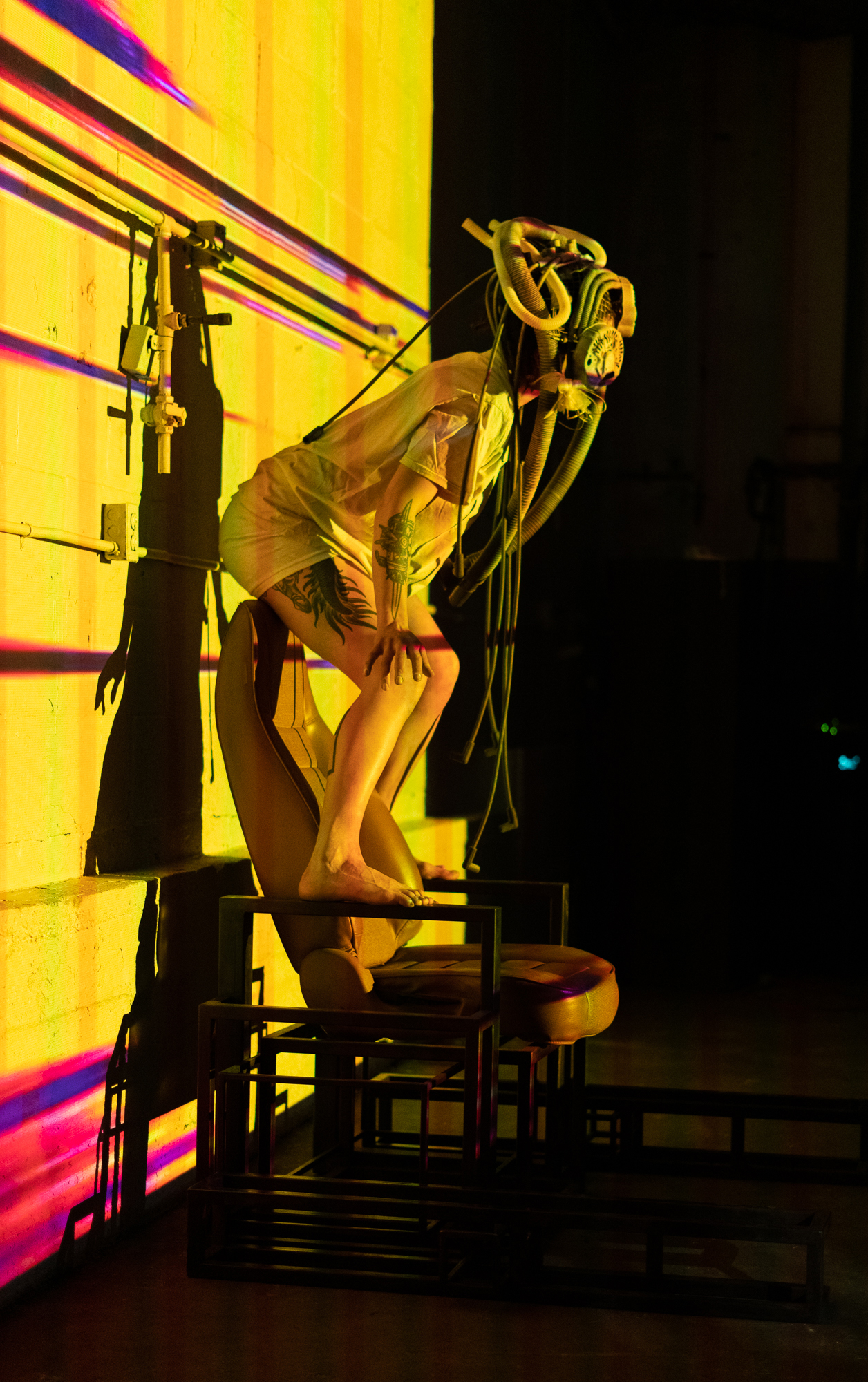
Mïï: Indeed. Divine desperation. Ï had been doing a lot of organizing work at the time and told Miriam Marcus— an elder Cass Corridor artist who paints dreamy and heart-wrenching-scapes of Detroit— that Ï wanted to give her a show. Ï pitched The Idea of Detroit: a multi-generational group show centered around the idea of the city, named after a piece from the late Detroit poet, Jim Gustafson. My professor and dear friend, Ken Mikolowski, published it at The Alternative Press back in the 80s. Ï blame Ken for the poetic possessions that will forever grip mï, and Jim and that poem, for bringing mï—wide-eyed and voraciously green—here in 2009. The show was for Detroit Art Week, which, being an Aleiya Lindsey/Amani Olu production, meant chosen family, so Ï had to come correct.
Ï had a studio at the Recycle Center for years—an epic, decaying industrial complex that many moons ago housed the Lincoln Motor company. It was one of the last cheap spots left for the freaks, and was often referred to as “Trash Babylon”. Like any proper battle with forces, a summer storm rolled in, the ceiling opened up in my studio, and the sky fell through. Ï last minute had to find a new venue, and you, miraculously, agreed. Ï knew Arnold’s was big shoes to fill, so we invited more artists, and with our powers combined, we did it up. It was a family (and chosen family) affair. My sister tended the bar, and Charles Trees and my brothers, Benny and Zach, DJ’ed. There was a stunning display of original postcards and publications from The Alternative Press under bulletproof glass, and Gustafson’s niece gave us a recording of him reading his poem on Detroit Radio in the 90s, shortly before his death. There was a material-nostalgia correspondence that Ï felt abundantly grateful to be witnessing. Zach was playing these heavy tracks along with the Gusto poem, running it backwards and so low it felt like an incantation.
Here was this auto cathedral singing and different artists and friends and neighbors and art folks, syncing through time and memory, in praise of the pursuit. Next to a floating wall of Miriam’s paintings of things flowering from the Piquette Plant and the abandoned cleaners on Van Dyke with an AFRI tag on it. Her painting of the oil drums, suspended above the actual oil drums, in the corner where the oil changes were done.
BVS: I think that project revealed what a good team we are. I painted the whole front of the main garage for that show, to match the original interference// wall. It gave the space a sense of legitimacy compared to the ancient exhaust-stained white hidden by the fresh paint, Agreeable Grey. We poured equal effort into making it happen, and I came to understand you as someone equally capable of pouring Herculean effort into a Goliath sized task.
Mïï: Herculean, but also, low-key, in that freedom was inherent. Lightweight Herculean. What was agreed upon was a certain aesthetic of uplifting—if there is a void to fill, then the container is a quality of care and attention. That means folks will get taken care of. Ï would have to remind myself often, working together, and with Arnold’s-what do you want it to feel like? Ok, we can do that. It can feel that way.
BVS: That sense of care and reciprocity permeated much of the activity in the space. I fondly remember Shigeto holding down the DJ booth by himself during the opening for The Idea of Detroit til I was the last person on the dance floor. You were already family, but he and the guys from Portage Garage Sounds and I were becoming closer friends. In the fall of 2019 Charles Trees organized a rave in the space. It was around Halloween and Kenjiro and Shigeto bought a ton of decorations, including a 15 foot inflatable ghost. That party was the first time I saw Tammy Lakkis play live, in her dinosaur suit, just before her career really started to take off. She later returned to Arnold’s to film the video for “Hello??” off her first album Notice. In the video she dances in a much heavier dinosaur costume; I’ve always been impressed by her musical talent but was blown away by that display of stamina.
I appreciated working with the PGS crew because they had a lot of the same ethics as I did regarding hosting and hospitality. Having done several performances in NYC and London in DIY spaces where I was promised some cut of the door and was never paid, it has always been important to me as a coordinator to pay people A.S.A.P. In working with those guys we always gave ourselves the slimmest cut to be sure we could dignify the performers’ effort with a decent rate. Getting people paid feels good!
Mïï: (Tammy in the Dino suit is also one of my favorite Arnold’s moments).
It’s easy to talk about DIY spaces in a very specific way–– i.e. low/no budget, scrappy, non-commercial. What is often left out is what comes with the agency for shaping an experience. There were such intricately concentric narratives being interwoven (both among friends & communities but also geographies, eras.) You and Arnold’s invited the kind of collective visioning that comes with DIY space, but also a care and dedication to exalting what the space can be for every iteration, that catalyzed as a kind of flex. There’s no doubt what was happening at Arnold’s was a labor of love, but also, it was fresh, and it felt right, and people wanted to find their place in that.
BVS: It’s interesting how a simple exchange can blossom; after a sudden displacement from their studio Levon Kafafian stored their fabulous collection of looms at Arnold’s. At the time they also needed rehearsal space for an upcoming performance at the Sidewalk Festival with the Fringe Society, their collaboration with Ash Arder. I joined the following year’s performance as a slow-moving extraterrestrial plant, and became fascinated with Ash’s practice and approach to making.
While Ash was doing a residency in Nebraska in 2021 she invited me to provide logistic support for a new iteration of a project called Solar Party. Solar Party was getting off the ground with their business which provides mobile solar powered generators and entertainment setups for events. One of the units, Josephine, weighed about 300 pounds, so transporting her safely was no joke. That summer Diane Cheklich (a founding member of the women-led team) and I huffed and puffed hauling her around in my truck. It was hard work, but it was also rewarding as I felt aligned with the project and its mission.
I kept helping out after Ash returned to Detroit and new units were added to the fleet. Around this time I began sorting the densely packed parts room. It was full of alternators and starter cores and all sorts of casings and components. In the process of organizing I found parts that were strikingly beautiful and began setting them aside for sculptures. A few months into this, Ash asked if I had any auto lights sitting around. I was excited that someone else was interested in the old stock, and every few months I’d give her a milk crate or two of things I had found which initiated a dialogue.
Mïï: Indeed, the material conversations were ongoing. It seemed to mï that what was leftover from the days of initial use was often found in shapes of suggested sculpture in the back crevasses of Arnold’s. Part of the building/imagination cultivation perhaps—that the mufflers and spark plugs get rearranged. It never seemed like a rough draft, though. It was more organic: a figurative watering, or tending to.
BVS: We both felt a resonance in these discarded parts, their relationship to our bodies as potential users. This resulted in a collaborative exhibition called automata, which showcased the early efforts of projects we are both continuously working on that incorporate car parts.
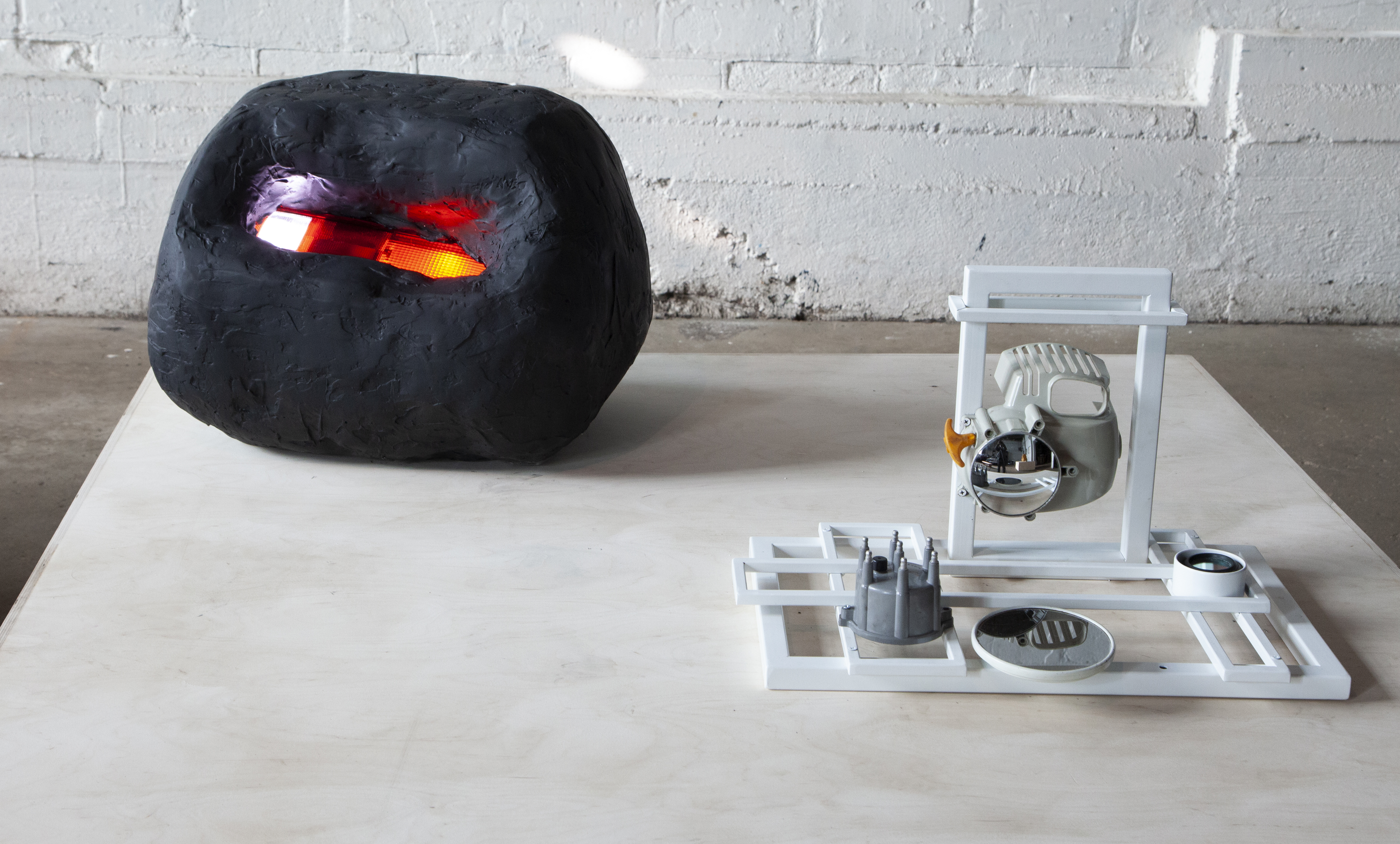
By the time automata opened I had come to the difficult decision to put the building on the market. I better understood the work the building would need to last into the future. I didn’t have the funds necessary, and wasn’t prepared to go into overdrive trying to monetize the space.
The pending sale generated an incredibly productive and exciting final season at Arnold’s. We had another Portage Garage Sounds party, where I brought the Joan of Arc performance with the chain hoist back, as the garage had the perfect infrastructure to support it. The Saginaw Brothers and Kirill Slavin of Detroit Industrial joined me in creating the soundscape. I decided there should be food for the crew and performers, so I made a giant pot of borscht. Literally nourishing so many of my friends was a high point for me.
As someone close to me and the space you were aware of my plans, so we decided to do a final group exhibition called The Auto Show. An automotive themed art show flowed naturally from automata, and I wanted to do something that would resonate with the space and its history, something that my neighbors would want to come to.
As with The Idea of Detroit there was a diverse range of artists included and so many different approaches to the theme. I’d say the scale of the installations was much more ambitious, like your epic tire braid.
Mïï: It felt like Arnold’s wanted that. A last dance. A moment of what it is/what it look like in a full exchange. The tire braid was a last gift to Arnold’s. Named “The Subtle Body,” it was an orgone accumulateur woven together of 70 used tires with kintsugi-painted gold in the cracks, and braided in with phragmites—an invasive grass that poses a significant biological threat (also known as street wheat). Just in that corner alone there was such an intricate material exchange of history/mythology. The tire braid voicing industry and alchemy (and ecosystems of chaos), through the social properties of arrangement.
The copper pyramid that you made for mï was hanging overhead, charging up in the light of the sign from Grena- dier Club, the cherished house of dancing and debauchery that had just burned down in the neighborhood. The tires came from Arandas Tires in Southwest Detroit, where a friend named Angel had worked forever, before disappearing. That one was named: “The Holy-Hand Grenade/ Are You My Angel?”
Next to the tires, Halima Afi Cassells and Erik Paul How-ard installed a 1976 Chevy Monte Carlo-turned low-riderthrone, holding images of car club members like kings, decorated appropriately in overflowing gold and flowers, with loaves of bread offered up on altars of bulletproof glass. It was called “Breaking Bread: A Seat at the Table”, and centered the kinds of royalty we were hoping to uplift.
When we were finished with the show the tire braid went to the Mike Kelley Mobile Homestead at MOCAD—to Halima and Shanna Merola’s exhibition, Swan Song—an intricately wonderful show about imperialism and environmental disaster—which felt appropriate. And ï got to drive the Monte Carlo home.
There’s no being in Detroit without feeling the impact and effects of the auto industry, and there’s an inescapable car-consciousness in this world. We seized an opportunity to shout out the folks in the shops and trades that rarely get love, but who support our joyrides, and set the motion of our days. There was a cocktail reception for industry professionals and mechanics and invited folks to bring their lowriders, classic cars, and art cars for a proper auto show at the opening. We called the shops our spiritual sponsors, because in this city, keeping someone on the road is some form of divinity.
The show was also your last gift to the Arnold’s community. The stages of the Ford Taurus, the delicate and frequent handling of car parts, the ballet mechanique of the chain hoist and decorum of oil spills were never in short supply in the other Arnold’s moments in your time, but The Auto Show was something to work up to. The heroic vertical in- stall of the Taurus, which, to date, is my favorite piece tohave ever seen come together. In the oil and fog, it seemed to recognize and approve of the gesture. Things had been leveling up to that, and automata, in its tender reverence, fully opened the road.
BVS: Yeah, Carcissus was the epic final form of the Taurus. Eric Froh and I teamed up with our friend Colin, who is a talented rigger, and hoisted it up so it was fully perpendicular to the floor. We had to cut most of the front end off so it would fit beneath the rafters. Camilo Pardo stopped by and mentioned how cool it would look if it had been set up on a mirror, as they do at lowrider shows so you can see the undercarriage of the car. I just happened to have some giant mirrors, so I set them up as close as I could, which is how the piece became Carcissus. It was completed with a puddle of oil and a smoke machine.
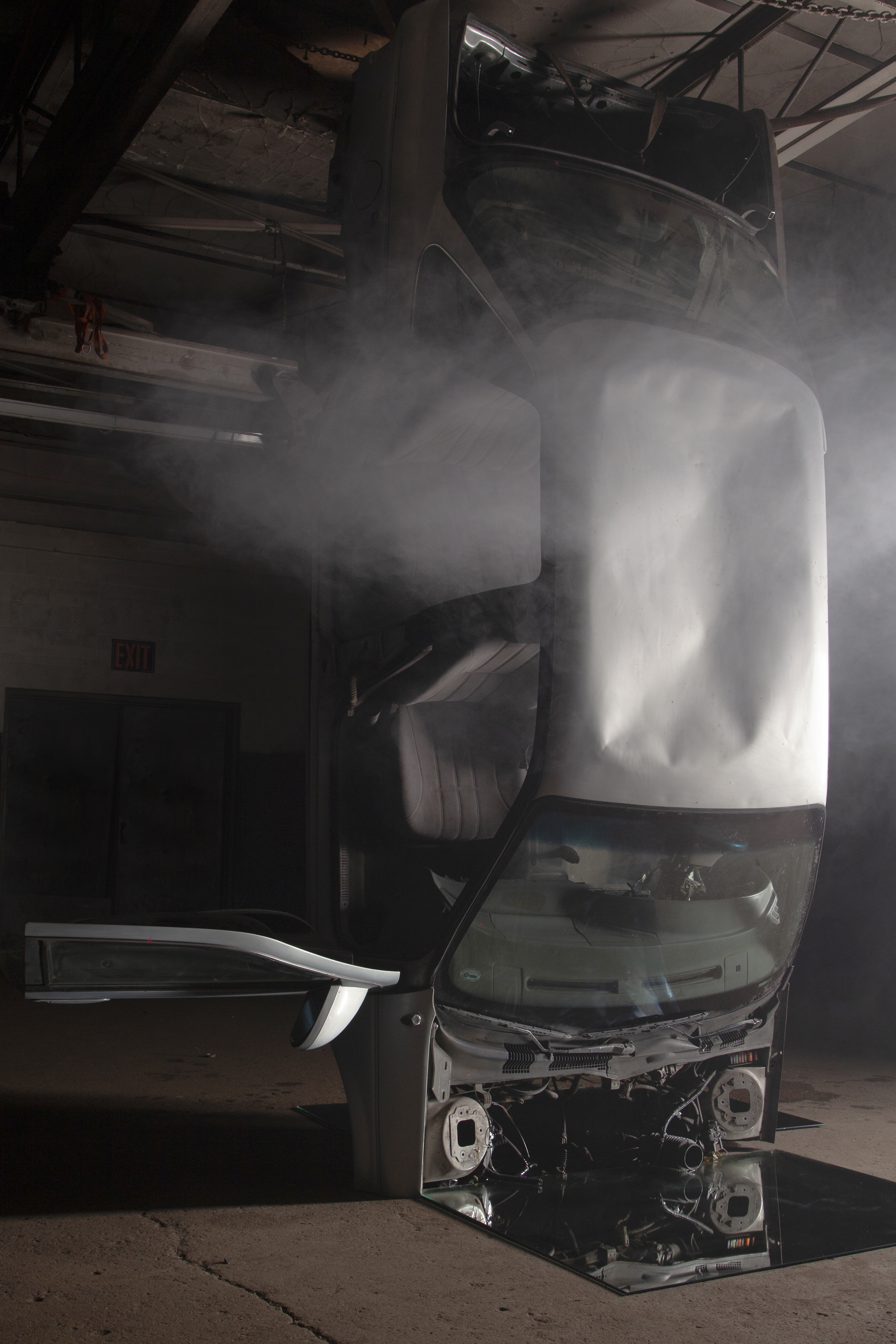
It was next to a piece of carpet from COBO which Ash had brought in, which was in front of the DJ booth. She DJed that night as Mount Mariah, going b2b with our beloved Lex-N-Effect. Bringing these two together was another high point for me, I’m so glad you were able to get Lex in the door. It took me back to the good old days at Krystal’s Korner, the local bar by the Packard Plant where you first introduced me to Lex, a butch auntie with a twinkle in her eye who played the best throwbacks.
Mïï: Oh, that was a celestial point. The Auto Show brought such lush combinations together, and car-ness really lends itself to a flagrant over-doing. We invited contributors who had been a part of Arnold’s over the years, pulling out all the stops in our homage to the past lives of the building, and the glory of a collective celebration. A friend introduced us to Krystal’s about a decade ago for his birthday, and we made a practice of dancing there with DJ Lex for all of our most momentous occasions. Being able to track down and hire the Old School Queen for Arnold’s last Throwback Thursday, to luxuriate in the sound/space with Ash, and a whole gaggle of new angels, that was it. Highest honor.
Showing people what you got is a gift. Sharing it is even better.You helped mï understand the subtle art of stunting as gratitude work. And it’s been a pleasure.
What does it look like now? What’s next for you and for Arnold’s, and what are you taking from this time into the future?
BVS: Arnold’s is currently under a land contract with Diane Van Buren, a member of Solar Party and one half of D2 Solar which offers refurbished solar panels. She’s taking the building completely off-grid. Among her tenants is the Audubon Society, who have plans for turning more vacant fields in the neighborhood into native grassland parks. While not getting paid up front for the building has been difficult for me financially, I felt this was the right move in terms of the legacy of the space. Solar Party is also based there now, and Ash and Diane C. have been coming up with inventive uses for the space. It feels good to be looped in on Arnold’s new life.
I’m hoping to use the proceeds to pursue an MFA in sculpture. I have a ton of auto parts I took from Arnold’s which I’m still incorporating into new work. A series of transmutations brought me to Arnold’s- a midnight shooting gallery became a court case which became a reason to return to the city. The house I grew up in became a point of departure and the funds for the building. Now Arnold’s and all it has given me will seed a new chapter; I’ve been enjoying seeing my sculptures recontextualized on clean white gallery walls in LA, where I’m currently living. I’m still processing my experiences. This conversation has been a solid step towards that, and I’m grateful for your insight and to Runner for the opportunity.
People contributed to the life of the building in so many ways, and it was impossible to mention everyone and describe their involvement in the conversation above. We would like to take a moment to thank the many artists who contributed visually or sonically and to the folks who sponsored us or generally helped out. Here is our honorable mention list which is far from comprehensive:
Zarah Ackerman, Halima Afi Cassells, The Alternative Press, Ash Arder, Arandas Tire, Art Basel Thrift Store, Onyx Ashanti, Philip Atkinson, Brook Banham, Ed Banks, Amiri Baraka, Başak, Kat Bear, Bestial Mouths, Bloomtown Detroit, Sarah Cavaleri, Gabe Chess, Sarah Grace Couyoumijan, Robert David-Jones, Detroit City Distillery, Detroit Grease, Diesel Joe, Downriver Vogue, DJ Lex -N- Effect, Ryan Doyle, Milana Duthie A.K.A. Share Crackers, Edethism, Danya Ensing, Ffty, Amy Fisher Price, Eric Froh, John Gerlock, Sky Naomi Goodman, Jim Gustafson, Hamtramck Ceramck, Erik Paul Howard, Jason Huffines, Iris Rainbow, Jessica Janda, Levon Kafafian, Blythe Kim, Tammy Lakkis, Taru Lahti, Mack Garage, Miriam Marcus, Juan Martinez, Colin Massa, Joey Meland, Mirror Boy, Motor City Brewing, Mount Mariah, Miles Michael, Millefolium Collective, Ken Mikolowski, Multilevel Rug Market, NO MTN, Norden Aquavit, Amani Olu and Aleiya Lindsey, Onami, Ouizi, Camilo Pardo, Iman Payne, Pat Perry, Charity Ponter, Alex Porbe, Red Bull House of Art, Victoria Rose, Ben Kenjiro Saginaw, Zach Shigeto Saginaw, Bob Sestok, Shingy Pop, Kirill Slavin, Peter Sonnenberg, Supreme, Margherita Tisato, Charles Trees, Chris Turner, Turtle Bugg, George Vidas, Kaylan Waterman a.k.a Vespre and Kellan Lee.